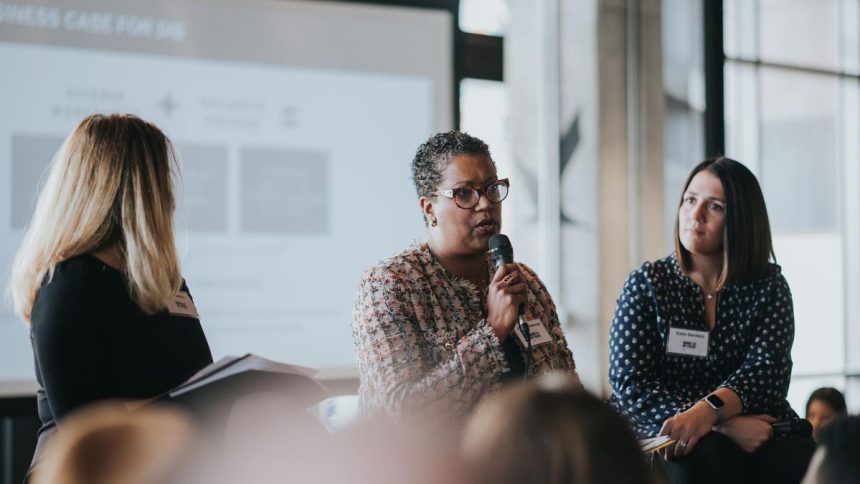DEI fatigue is increasingly a reason for the ongoing divestment from diversity, equity, and inclusion efforts.
I spoke to four leaders to dissect the complex dynamics of DEI fatigue, unraveling the genuine exhaustion felt by DEI practitioners from the more resistant stances cleverly positioned as fatigue. As I explore these narratives, I aim to shed light on how organizations can better understand, address, and navigate the intricacies of DEI in today’s world.
At its core, DEI fatigue embodies two distinct narratives.
On one side, there are tireless DEI advocates continuously pushing for change often with limited resources and against tremendous institutional inertia. These champions are genuinely exhausted, seeking meaningful support and understanding amidst an often isolating battle.
Nadia Butt, an organizational development and belonging strategist and co-host of the Inclusive Collective podcast affirms the sense of deep exhaustion felt by practitioners and advocates, especially those from historically underrepresented and undervalued groups.
Butt is a woman of color, who works with both SMEs and Fortune 500 companies, and is increasingly seeing, “sentiments of frustration, isolation and exhaustion” resulting from “a discernable decline in leadership support and commitment, and a reduction in investment and interest towards DEI programming which is inhibiting organizational DEI progress.”
Another source of exhaustion is the burden of coaching and educating colleagues who have privileged identities and tip-toeing around difficult conversations. She notices, “an avoidance of having conversations on complex topics related to race and gender inequities, pay transparency, sexual orientation, disabilities, etc., causing feelings of resentment.”
There’s also exhaustion stemming from being one of the few or only in an organization. Kris Martinez an internal communications leader at Oyster, confessed to being tired of the continued lack of representation of people of color in leadership roles – “I’m tired of the fact that only 1% of Fortune 500 CEOs are Black. I’m tired of the fact that companies show a glimmer of hope and then fail to deliver.”
The exhaustion DEI practitioners feel is distinct from institutional DEI fatigue; a sense of weariness or frustration towards diversity, equity, and inclusion initiatives.
Leaders predominantly from privileged backgrounds, express a weariness that is less about exhaustion and more about resistance. Under the veil of fatigue, there’s a reluctance to continue funding and supporting DEI efforts – even inside organizations with progressive leadership. In a rapidly changing socio-political environment, these leaders’ claims of fatigue might be a reflection of broader societal pushbacks against progressive change.
Stefani Coverson, a doctoral candidate and CEO of Jamii Pae Consulting, notes that “the way DEI Fatigue has largely been framed is ‘we are tired of talking about race, and we want to focus on other kinds of diversity’. There seems to be fatigue around addressing the impacts of race and racism— particularly anti-Black racism and misogynoir.”
Coverson, a Black woman, argues that what is positioned as fatigue is, “simply pushback against having difficult and honest conversations about how people with racialized and minoritized identities are experiencing an organization’s culture versus those in dominant identity groups – despite having access to data demonstrating these disparities exist.”
This fatigue experienced by those with racial and socio-economic privilege, many of whom faced the reality of deep and systemic inequities for the first time after the murder of George Floyd, feels comical in contrast to the experiences of marginalized groups.
Martinez threads the needle, saying, “We’ve been fighting for civil rights for decades, and corporations thought they could affect behavioral and societal change in just three years. Now we’re facing economic realities where DEI no longer fits in the P&L.”
The pushback and divestment from corporations who pledged unspent billions just three years ago is not surprising given the historical context.
A lawyer turned anti-racism advocate, Karen Fleshman, says that the roots of resistance go back decades. She sees this “as a continuation of the massive resistance white people organized against desegregation following the 1954 Supreme Court decision Brown vs. Board of Education.”
One of the ways the resistance manifests is in the constant shifting of goal posts.
Coverson, a doctoral candidate and practitioner with over 20 years of experience, paints a picture of the push and pull nature of equity and inclusion; “For example, in response to ‘listening and learning’ and ‘changing hearts and minds’, internal and external DEI practitioners used storytelling and real-life experiences to illustrate how systems of oppression and barriers to inclusion have impacted people with racialized and minoritized identities. Then the critique shifted to the work focusing too much on ‘feelings and sharing personal experiences’ leading to requests for ‘the business case for DEI’. Practitioners and advocates made the business case, including a financial return on investment (ROI) for diverse teams. Now I see the pushback on qualitative data (e.g. interviews and focus groups) being ‘anecdotal’ and survey-based quantitative data discounted by attacking the tool when these methods uncover disparities.”
However, a new generation of employees with a deep awareness of systemic inequities and burgeoning race consciousness is pushing for real change. Martinez notes, “Employees don’t want an all-hands meeting on DEI; they want to see people of color and those who identify within minority groups actually getting hired into positions, recognized for who they are and their work, and given opportunities for growth.”
How then do we move forward?
Fleshman’s call to action is for people with marginalized and underrepresented identities to come together. She says, “People who do not benefit from the status quo must unite and overcome our internalized oppression and -isms about each other. We make up the majority.”
This includes white women, who form the majority of DEI practitioners and executives, as well as HR leaders.
Fleshman, says “When white cis-gender women like me unlearn our racism and internalized sexism, we will be able to unite with BIPOC, queer trans and nonbinary people, we will have the numbers and power we need to change every institution in our society. But as long as white cis women’s allegiances are to white cis-gendered men, we will remain mired in this mess”.
Along with unlearning —isms, these leaders offered considerations for organizations who’ve fallen into the trap of DEI fatigue.
- Model inclusion: Leader values are the single greatest driver of meaningful DEI efforts. Leaders’ attitudes and behaviors are pivotal in shaping culture, and their response to DEI significantly influences their organization and the larger ecosystem.
- Invest in real change: Piecemeal and surface-level efforts are harmful. Allocate the necessary resources to advance DEI, and build equity into how you work. Integration of DEI into the organization’s core functions ensures a more profound and meaningful engagement. This includes not just people functions such as hiring, onboarding, and advancement, but also where equity cuts across supplier diversity, learning and development, product development, grants management, and more.
- Govern with equity at the center: Boards and governance structures must consider DEI as integral to organizational success and integrate DEI into the organization’s core values and long-term strategies. This includes transparent metrics and building accountability structures that ensure DEI isn’t sidelined but remains a focal point.
Martinez, an Afro-Latino man with a front-row seat to these shifts is clear on what it takes to do this work well, “if DEI fatigue is not happening within the workplace––the organization isn’t doing the real work to make change.” In this instance, fatigue is akin to sore legs the day after a challenging hike, or making chicken biryani from scratch. Even as these experiences push us, the effort is well worth it.
He candidly notes, “Leaders who mask DEI efforts by ticking the boxes with commissioned reports or broad commitments aren’t going to feel fatigued because there’s no real action.”
In his opinion, “organizations that really believe in building intentional DEI frameworks are making it a strategic priority to do so—those that don’t, aren’t.”
Read the full article here










